Importance of Continuing Eduction for Yourself and Your Employees

8 Common Construction Estimating Mistakes
How to Estimate the Cost of Acoustical Ceiling Clouds

AMERICAN SOCIETY OF PROFESSIONAL ESTIMATORS
AMERICAN SOCIETY OF PROFESSIONAL ESTIMATORS SEPTEMBER /OCTOBER 2023
TODAY ESTIMATING
ASPE BOARD OF DIRECTORS
President
M. Chris Morton, FCPE cmortonfcpe@outlook.com
First Vice President
Mike A. Alsgaard, CPE maalsgaard@aspenational.org
Second Vice President
A. Keith Parker, CPE keithparker@circlebco.com
Immediate Past President
Mel D. Cowen, LCPE mel@cowen-est.com
Treasurer (Appointed) Paul Croke pcroke@hinrest.com
Northwest Governor Steve Watkins steve.watkins@bnbuilders.com
Southwest Governor Larry Lucero, CPE llucero@redlineinsulation.com
Central Plains Governor Matthew Burress, CPE mburress@performanceservices.com
Southeast Governor Danny Chadwick, CPE estimatordan@gmail.com
Northeast Governor Dexter Murphy,
INDUSTRY DIRECTORS
Barbara J. Jackson, PhD, DBIA Barbara Jackon LLC
Jean Arnold, Esq Arnold & Arnold, LLP
LCPE dextercmurphy@comcast.net
WHAT IS INSIDE FROM THE PRESIDENT NEW MEMBERS THE HIGH COST OF THE LOW BID LIKE SANDS THROUGH THE HOURGLASS 8 COMMON CONSTRUCTION ESTIMATING MISTAKES CHAPTER MEETINGS 03 07 08 12 22 24 32 HOW TO ESTIMATE THE COST OF ACOUSTICAL CEILING CLOUDS IMPORTANCE OF CONTINUING EDUCATION FOR YOURSELF AND FOR YOUR EMPLOYEES 04
From the President
you know others who would benefit from one or more of our classes. Please spread the word. If you are new to estimating, I hope you take the time to look at our classes and consider enrolling now. More information can be found on our website at www.aspenational. org.
Finally, as always, please feel free to contact me, a board member, or Joanne Warren, if you have any questions or suggestions on how we can improve our Society. Thank you for your continued support of ASPE!


It is hard to believe that summer is over! I hope that you have had a great year so far.
The Governance Committee and Executive Director Joanne Warren continue to meet to work on our new strategic plan. However, there is still much work to be done before we will be able to share the plan with all members. Please stay tuned for details in the coming months!
I hope that you will be attending our 2023 Summit, either in-person or virtually! If you receive this copy of Estimating Today before the Summit starts on September 22nd, you still have time to register and attend virtually.
The Board of Directors election ended on July 21st, and I am excited about our new board members that will take office on January 1, 2024. Congratulations to our new incoming officers and new Central Plains, Northeast, and Southwest Governors!
Our next round of Estimating Academy (EA) classes will be starting on October 9th. If you are an experienced estimator, I am sure that
September/October| 3
Connect at: CMortonfcpe@outlook.com LEARN . CERTIFY. JOIN
Welcome our June & July New Members
4 | Estimating Today
Member Company Chapter Christopher Ajagu Mantis Builders Los Angeles - 1 Kenworth Budd Mopan Enterprise LLC Los Angeles - 1 Robert Peters Grady Electric Inc. Los Angeles - 1 James Escudero Incan Project Development Group Inc. Los Angeles - 1 Jorge Nieto UES Los Angeles - 1 Sandra Choi Construction Los Angeles - 1 Humberto Montiel Charter Concrete Inc. Los Angeles - 1 Sam McClintock Golden Gate - 2 Mark Ricardo Team Reliant Inc Orange County - 3 Rex Le Largo Concrete Inc. San Diego - 4 Jeff Alley Smalley and Company Denver - 5 Scott Welch Sun Construction and Facility Services Denver - 5 Erik Simms Achen-Gardner Arizona - 6 Houda Gaffka Bedrock Detroit - 17 Austin Stovall Course Construction Group Houston - 18 Rob Filho EFR Mechanical Boston - 25 Kenneth Prusik C. Raymond Davis Garden State - 26 Cody Sebastian Marsh Building Products Southwestern Ohio - 38 Josh Long MKA International Inc. Southwestern Ohio - 38 Aubrey Wade Cincinnati State Technical Southwestern Ohio - 38 Joe Estrada ML Crane Group - Crane Service Inc. Rio Grande - 40 Kirk Davis Con Tech Building Systems Inc. Empire State - 42 Ammerson Barber Navajo Engineering & Construction Authority Roadrunner - 47 Ghazanfar Barlas ACCO Engineered Systems Silicon Valley - 55 Thomas Evans Hensel Phelps Silicon Valley - 55 Steven Bueno S/L/A/M Construction Services Nutmeg - 60 Chase Hatten Henning Companies Des Moines Area - 73 William Fullard RK Kearey Construction Southeast MAL - 93 Benjamin Cargill F.W. Madigan Company Northeast MAL - 94 Matt Podojil John G. Johnson Construction Northeast MAL - 94

September/October| 5 Congratulations to June & July New CPEs & AEPs Preconstruction in the Cloud Use STACK to power a 10x faster and more profitable preconstruction process. Quickly measure digital plans, collaborate with team members and finalize project estimates — all from one, easy-to-use, cloud-based platform. Plan, Spec & Document Management Make project takeoffs 10x faster & empower your team to work anytime, anywhere. Keeping project details & supporting documents organized has never been easier. Adjust costs, markup, tax, and overhead to create branded proposals with ease. Use robust markup, callout, sharing & invitation features to keep your entire team aligned. Cloud-based Quantity & Material Takeoff Detailed Cost & Estimating Proposal Generation Real-time Collaboration & Connectivity Your all-in-one solution for lightning-fast takeoff, complete estimating & bid-ready proposals. Create your FREE account today! GET STARTED stackct.com | (866) 702.6078 Member Company Chapter James Zack, AEP DS Constructors LLC Denver - 5 Giocondo De Filippis, AEP Greenstone Construction LLC Roadrunner - 47 Jeff Peterson, AEP nStone Corporation Roadrunner - 47 Nolan Johnson, CPE A/Z Corporation Nutmeg - 60 Brian Logie, AEP Newfield Construction Nutmeg - 60 Hans Brubaker, CPE EGStoltzfus Construction LLC Central Pennsylvania - 76 Aaron Schoenthaler, AEP Garver Southwest MAL - 91 Curt Winn, CPE City and County of Denver Nathan Hunter, CPE Broadmoor LLC Sam Cannon, AEP Flint Builders Dustin McMillan, AEP The Concord Group Jason DePalma, AEP

6 | Estimating Today Thank you to our Corporate Partners! Corporate Members Gold Anser Advisory Silver STACK Construction Technologies Bronze Delta Innovative Services, Inc. Basic ML Group Unfied Building Group Shaw Electric Inc. GW Builders, LLC. GFP Cement Contractors, LLC Bluebook | ConsensusDocs | DCD
Importance of Continuing Education for Yourself and Your Employees
 By: Josh Huck | Estimatica, Inc.
By: Josh Huck | Estimatica, Inc.
If you ask my 13-year-old son, he will tell you that he already knows everything. I've quizzed him thoroughly on random occasions and surprise surprise, he doesn’t. I thought I knew everything as well. I hate to admit it but this train of thought continued a bit too far into my twenties. While my emotionally immature type-A man brain still trips me up at times, I do my best to learn something new every day. Eventually one day I had the benefit of a company owner I worked for offering to pay for a continuing ed course in Business Management. My 27-year-old self thought "I'm already further along than most in my field, what do I need to know? In retrospect, I have wanted to smack my younger arrogant self on the side of the head for many reasons, but primarily for thinking this way, that I had nothing left to learn.
So, I took the course, and it wasn’t necessarily the course material that was eye-opening but rather the instructor's knowledge and my fellow students' knowledge. My younger know-it-all self was learning alongside people two and three times my senior—CEOs, VPs of major corporations—and it was immediately humbling. I learned more from my classmates than anything else. I learned that I don't know everything and most importantly I learned that I never will. I remember listening to my classmates, ACTUAL titans of industry, asking for help, seeking to learn. I thought to myself well hell, if they can keep an open mind to learning every day, then I should as well if I want to be successful personally and professionally.
I started offering estimating training a few years back, and I have learned more than I have taught. It's easy to know about something, it can be very difficult to teach what you know to someone else. Since we have offered classes, we have had the benefit of teaching nationwide to a variety of contractors, owners, and design professionals and in doing so, it made us better at our job. It has taught us how others think and how that should affect how we think about not only our role in the food chain but all roles.
The long and short of it is that learning something new every day, even a trivial fact or a seemingly menial task, is important for personal growth. For professional growth,
it is important to keep taking classes to gain the required knowledge to stay abreast of how the world is evolving. It helps us in our jobs and I've noticed that the real benefit is that it helps us grow as a human, and this comes more from the interaction with other professionals. As an employer of others, I was able to return the favor recently and send our head of Business Development back to school. She is deeply invested in advanced business strategy courses at the University of Virginia. The investment in her financially will have a ten-fold benefit, not only to our company but to her personally. When you learn new things, you gain confidence, which trickles down to all areas of your life. It's a win-win all around for a minimal investment of time and money.
My point of all this is that continuing education is paramount. As a business owner, investing in your employees often leads to benefits for you but on a higher philanthropic level, investing in others benefits humanity as a whole, as sappy as that may sound.
If you are an industry professional, I implore you to teach. We need more teachers. We need the next generation to learn not only professional skills but life skills from those that have been there and done that. I learn something new every time I teach…a new way of doing something, a better way of thinking about something. I learn something new every time I take a continuing education course, and that is mostly from my fellow students. Continuing education benefits us all for many reasons beyond the syllabus.
September/October| 7
The High Cost of the Low Bid
“The riskiest position that any owner can find themselves in on their construction project is when working with a contractor who is losing money.” This is the warning that I give every owner or developer planning to go with the “low bid” approach on their project. Yet many owners still believe just the opposite—that making contractors compete on a low bid basis is the best way to “protect” themselves and ensure that they get the cheapest price. Well, they are right on that front— they’ll get the cheapest price alright, but they won’t necessarily get the right price or the project they want. At least not without a bunch of change orders resulting from things missing in the design documents that neither the owner was knowledgeable enough to detect, or the architect was aware were needed in the first place. This is just one of the reasons that I am such an advocate for design-build or any approach that allows the designers and contractors to work directly with the owners at the earliest stage—to establish the “right price” for the level of performance and value the owner expects. This can’t happen in a siloed, segregated environment. And because contractors are often the last party invited to the table, and forced to compete based upon low bid, they can only price what’s in the documents and nothing more if they expect to win the job. As a former project estimator, I know firsthand how the game must be played in a low-bid competition, and it serves no one’s best interest—not
the owner, not the architect, and not even the contractor. It’s downright frustrating to be constrained from offering up your expertise and knowledge because of some antiquated process that was conceived some 150 years ago. This approach is a lose/lose proposition but here in the United States we are addicted to this low-bid mentality. In a sentence—we are addicted to cheap, and it is at the core of what has held this industry back for so long. There’s a very high cost to the lowbid mentality. It has kept us from addressing major issues in our industry such as the chronic albatross around our necks—low productivity; not to mention the absence of innovation, the lack of research and development investment, and the failure to embrace technology at a level that would catapult the industry to a whole new frontier. Many owners still insist that they must go down the low-bid track to get a fair price. I always wonder –fair to whom? Is it fair to anyone to price improved productivity, higher quality, innovation, originality, and better performance out of the spaces we design and build? Spaces like schools, and hospitals, and workplaces, and even our homes? What’s so fair about that?
Let’s get real. When folks say they want a fair price, they often mean they want a cheap price. Fair is getting what you pay for. Fair and cheap are incongruent when your expectation is something other than what cheap delivers. Have you ever watched a baseball game

or a concert from the cheap seats? Yeah – the nosebleed section with binoculars. Cheap begets cheap. Fair implies reasonable, honest, and just—NOT cheap. And yet that’s what many owners demand of contractors—a cheap price, and in the same breath complain that the quality just isn’t what it used to be. Really?
Let’s STOP confusing low-bid for a fair price. The reality is that Americans, including buyers of construction services is addicted to cheap (developers, government agencies, private business owners). If you want to understand just how much this addition has cost us as a nation, read the book “Cheap – The High Cost of Discount Culture” by Ellen Ruppel Shell, written in 2011. As one reviewer shared,
“Americans have always loved a good deal. But that love has evolved into a destructive obsession. Our never-ending hunt for discounts has fed a plethora of social ills. By moving our production to the lowest-cost labor markets, we have sacrificed such basic values as craftsmanship and product integrity. As Cheap ably proves, you get what you pay for.”
In the book the author points to what I think is at the core of the fallacy associated with the low-bid mentality in construction.
“Most of us have absolutely no idea what goes into setting a price. Consumers don’t think about the costs behind what they buy. They link price to profit, and they grossly
8 | Estimating Today
Barbara Jackson, PhD, DBIA | ASPE Industry Director | Blogs
what keeps the low-bid practice in play. This ignorance fuels our fear—the fear of paying too much. The fear of being ripped off. The fear of price gauging. Yet, according to Conexpo Con/Agg, “commercial construction is a high-risk industry with low profit margins. They state that the average profit margin before taxes for general construction services is just 4 percent,” and those margins continue to shrink. In today’s market the profit margins are probably closer to 1-2 percent given supply chain challenges, increased prices, and the labor shortage—not to mention the added expense of COVID. In what universe is a margin before taxes of 4 percent on projects that have exposure to multiple risk factors beyond a company’s control, over months and months, or even years of time, a rip-off?
They say ignorance is bliss but, in construction, the ignorance that keeps the low-bid mentality in play is a travesty that is hampering the advancement of the
So, what’s the alternative? It’s called best value and there’s a few different ways to achieve this goal while still utilizing a competitive process among project teams. Best value allows the owner to establish a reasonable budget for their project, hopefully in collaboration with folks who understand cost, quality, and the dynamics of the supply chain, without cutting corners. Then they can ask their design and construction teams to compete based upon the greatest value that they can provide for the established budget. You’d be amazed at how much more a team can offer an owner when they can leverage their knowledge, expertise, connections, ingenuity, and buying power to compete based upon their efficiencies, originality, and resourcefulness. Instead of general contractors beating the creativity out of their sub-contractors and suppliers so they can squeeze another few pennies off their unit prices to win your job, they’d be working together as a team to figure out how to give you more value than you
owners typically pay less for their projects under a best value scenario than they do under a low-bid scenario. The idea that low-bids yield a lower project cost is a myth—a myth that must be put to rest.
I am convinced that the low-bid mentality has outlived its effectiveness in the construction business. It is keeping us stuck. It is keeping us unproductive. It is keeping us from innovating and advancing as an industry. We are never going to be able to address the grand challenges and complexities of the built environment such as energy consumption, transportation, urbanization, infrastructure, housing, health care, education, etc. unless we can break free from the archaic notice that the cheapest price wins.

September/October| 9
What is CERT?
We are an organization of cost-estimating firm owners and estimating professionals that work for cost-estimating firms.


Why Join CERT?
Have you ever wanted to start your own estimating firm? This is the place to start. We provide detailed guidance through quarterly best practices calls, mentorship to junior firms, validation credentials, published Best Practices manuals, collaborative communication, yearly conferences, and a whole wealth of current knowledge on estimating and running a business. We share estimating and business ideas, help each other with staffing, and collaborate to provide estimating solutions for the clients that need them. We are your one-stop resource if you operate or are considering operating your own firm. For more information and to join, please visit Certusa.org.
10 | Estimating Today
WE’RE BUILT A LITTLE DIFFERENTLY AT ANSER ADVISORY.
We are a national capital program and project advisory firm comprised of world-class subject matter experts who each work tirelessly to deliver mission-driven outcomes for our clients
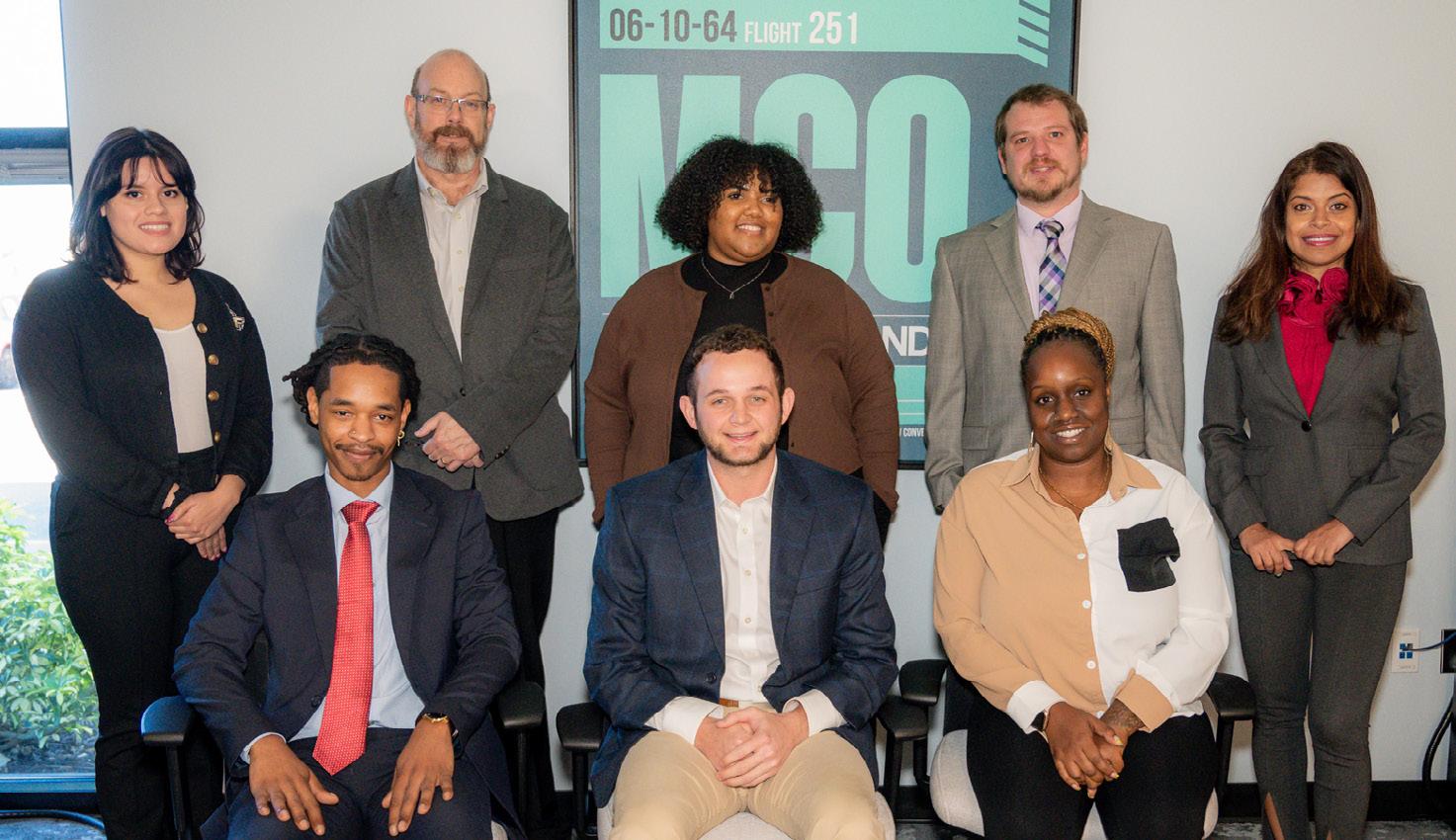
Working with us, you’ll see how we are redefining consulting.
When it comes to cost estimating for construction projects or capital programs, we make the complex simple
Any project, any size, any location – we can provide the accurate cost estimating information you need.
WE’RE STRONGER THAN EVER.
OUR SPECIALTIES
Construction Management

Program Management
Project Management
Quality Assurance / Quality Control
Cost Estimating
Project Controls
Utility Management
Contract Administration
Energy and Sustainability
WHO WE ARE
1,200+ National Professionals
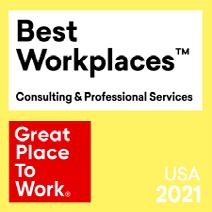
BINU MATHEW joins us and expands our expertise and experience into the New York / New Jersey area!

MICHAEL MARSHALL rejoins the Anser family and strengthens our presence in the Florida region!

200+ Local Florida Professionals


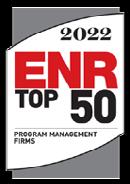
$15B+
Cost Estimating Program National Portfolio
100+ Programmatic / Conceptual Estimates Performed
PROUD TO PARTNER WITH ASPE!
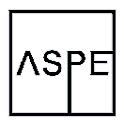
All our Cost Estimating Leaders are ASPE Members.
world class people. consulting redefined.
How to Estimate the Cost of Acoustical Ceiling Clouds

Introduction
This is an introduction and description of how to estimate the cost of acoustical ceiling clouds within a commercial facility. Over the course of the past decade or so, it has become increasingly common to incorporate acoustical ceiling clouds in a variety of shapes and forms as opposed to your typical wall-to-wall grid and tile systems. Ceiling clouds were designed to effectively reduce reflected sound in large and open environments as well as to delineate space. Stylish lines and shapes suspend horizontally from the ceiling
and absorb sound across their entire surface for acoustical performance. Ceiling clouds are an ideal solution for your general, all-purpose sound absorption needs. Effective at reducing reverberation within a room, they are commonly used in open office work areas, classrooms, worship centers, restaurants, lobbies, theaters, and/or recording studios. There are examples of common manufacturing companies as indicated in references. They offer many available products that are often specified depending on sound absorption, light reflectance, humidity, sag resistance, and fire rating
requirements. Material options are also offered in different elements of metal, fabric, felt, wood, colors, shapes, and sizes depending on the design and function desired.
MasterFormat Information
Division
09 51 00 - Acoustical Ceilings
Subdivision
09 51 13 - Acoustical Panel Ceilings
09 53 00 - Acoustical Ceiling
Suspension Assemblies
12 | Estimating Today
It is important to understand current trends and product knowledge, as there are cost impacts as opposed to the typical systems used in basic building environments. The purpose of this report is to provide detailed instructions on how to review the system types, identify potential risks, installation methods, quantity surveying, and cost estimating.

Types and Methods of Measurement
When developing quantity takeoffs, this is typically quantified by the area of Square Foor (SF), but it is
also important to pay attention to the perimeter Linear Foot (LF) quantity as there is usually some form of edge trim, especially if this is a floating cloud system. If the cloud is circular or multi-curved, you have to run an LF takeoff at the edge to estimate the correct amount of trim needed. Depending on what the basis of design (BOD) and fastening method is for the edge detail, there are many types provided by the manufacturer. This is a key factor for not only material supply but also the labor to install the product. There are different tile types which can also impact how tiles are cut to give the edge of the cloud a finished edge for each tile.
As a final note to measurements, there are many different systems in preparing a quantity takeoff. The most common method in the industry today is the use of digital computer software, which allows you to run takeoffs from a computer screen. This is excellent in reducing errors as opposed to doing this with pen and paper by hand. Also, by having this in digital format, you have a record for something to go back to if the need arises whereas in a paper environment, it can get lost and is not as easy to reference back to. Another method is the use of BIM technology, where the building is created in a 3D environment as a model, allowing for the use of quantity takeoffs if set up correctly. This has not become mainstream yet as many designers don’t always work in this environment, especially if it’s an alteration to an existing facility. Lastly, not all estimators trust this method and still double-check the takeoff in 2D anyway. It is always good practice to have another person check your takeoff too, especially if the project is of large scale.
About the Author
Mike
CPE Garden State - 26 mikemacdonald09 @gmail.com
As an experienced Pre-Construction & Project Executive with a demonstrated history of working in the architecture and construction industry, Mike provides leadership and expertise in Project management, cost estimating and consulting, quantity surveying, BIM & VDC management, design documentation, and construction execution and management, and contract administration. Skilled in managing commercial real estate projects, Mike acts as a liaison between design and construction teams to ensure that every detail translates from strategy to delivery while ensuring budget, scope, and timeline certainty. Mike began his career as a field supervisor, working his way up to project manager, operations manager, pre-construction manager, and his current role as a management consultant serving global clients.

September/October| 13
Macdonald,
Specific Factors
The specific factors that should be considered when estimating acoustical ceiling clouds are: what is the floor-to-ceiling height, what is the floor-to-deck height, what location and floor will this be installed on, what type of labor is allowed to be used (union, non-union, regular hours, off-hours), are there going to be any structural or MEPF systems that need to be worked around or coordinated with. Oftentimes, if there is a custom specified ceiling panel or curved edge trims, there is usually a longer lead time with the manufacturer and additional labor to install. Make sure any custom pieces are manufactured to be able to fit into the facility access points (stairs, elevator, exterior window). Depending on location, some states require certain support systems, so it’s important to follow the local building code (for example NYC requires a black iron system but in other areas, you can just simply use 12 GA hanging wire).

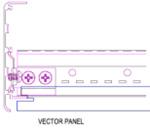

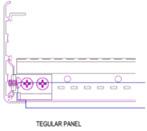



The fastener type to the deck is also important as the material you are fastening to could be a wood stud, metal deck, concrete slab, and/or steel joints. Lastly, as a note to the above reference to ceiling tile type, make sure to count enough tiles to have a finished edge when you have tiles with a revealed edge at the border of the cloud system.
Overview Costs
The following items need to be included with your estimate and breakdown using the CSI format. For the use of this estimate, we will use RS Means and DCD Costbook for unit costing. It is good to use multiple sources to cross-reference your estimate as well as stay current with the most up-to-date publications by those companies. Conferring with the
14 | Estimating Today
See sample takeoff
Sample edge detail
Axiom
Soft Edge Ripple
Axiom Soft Edge Soft Ripple
Axiom Soft Edge Convex
Typical fastener detail
Soft Corner Profile -Tegular Soft Corner Profile - Vector Ripple ProfileTegular
Ripple ProfileVector Convex ProfileTegular Convex ProfileVector
Lay-In
Sample tile edge type Tegular Panel
Panel Vector Panel
contractor and your own historical database is also good practice with estimating especially if there are custom systems involved. This is a brief description of each item and what should be considered and/or clarified in the estimate.
Labor
These rates are based on local availability and should be determined whether union, non-union, prevailing wage, overtime, or regular time is required specifically. Otherwise, state clearly what is estimated.
Material
Quantity is important to review as large and small quantities can impact the cost of a product. Oftentimes you can buy better with a large quantity. Also, it is good practice to consult with the actual installer to ensure you are allowing enough for tile cuts and material overages that may be required for custom curves. For this estimate, we will carry a 10% material overage in quantity to cover this.
Equipment:
Generally, a ceiling installation is used with simple hand tools and a ladder, but site conditions may be the deciding factor for working from a safe level and platform. Ensure you have accounted for either a ladder or scaffold depending on ceiling heights. Ensure all necessary PPE is on-site for personnel use and is in accordance with OSHA regulations. For example, we will consider ladders to be used with a ceiling height of 9’ and a deck height of 12’. If there is a stairwell or higher deck height, you may want to consider a scaffold system or man lift rental if the structure supports that. Lastly, confirm material delivery into the space is acceptable via the freight elevator, ground level, or staircase. Some cases may require a boom lift
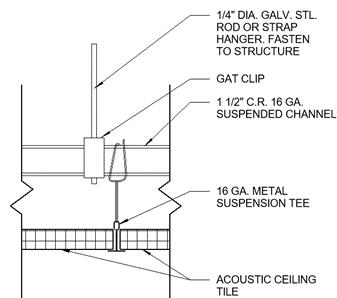
or crane rental depending on whether it is a large material delivery and what floor level it may be on.
Indirect costs
These are the contractor percentage markups of the construction hard costs. This should be broken out at the end of the construction hard costs or direct costs and typically are line items such as general conditions, overhead, profit, insurance, and contingency.
Approach to mark-ups

Typically, mark-ups are used as a percentage of construction costs, but this can depend on project size. If it’s a small project, the contractor may look at it from an estimated time to manage rather than a percentage, or it can be a higher percentage for a small project compared to a large project (example: $100,000.00 @ 20% or $10,000,000.00 @ 10%). It is always good to check with the contractor if you can, especially as this can vary by region of the country. For the purpose of this study, we will use 5% for general conditions, 10% overhead, 10% profit, 2% insurance/ bonds/permits, and 5% for contingency. An important note here, this report calls for markup, but some
contractors may use margin. It is important to know the difference between markup and margin (for example using rounded figures: 20% markup = 16.67% margin or a 20% margin = 25% markup). This can make a big difference in a largescale project for the costs to the project owner or can have an impact on profit for the contractor to stay in business. Either way, it will have an impact on your estimate so pay attention to it.
September/October| 15
Sample hanging detail with 12GA wire
Sample hanging detail with black iron grid system
Risk Considerations
Due to working with specialty finish products and custom metal pieces, there are certain risk factors to take into consideration. Will there be other trades working above or below the product during the time of installation? Can the contractor install it after the other trades have completed their work? (Example –MEPF trades are common to work above, and furniture/equipment being installed below). Damage to material can drive up costs, but also if there are large components to be worked around upon installation, it may require more time for the labor to work around it. Also, the required labor type can impact cost if this needs to be installed on overtime or union labor, so your wage rate should be adjusted accordingly. If there is a large material delivery, some building owners require delivery during a certain time period, so you need to understand what that time is, so your labor is accounted for. Working at high ceiling heights can also be risky and necessary safety precautions should be taken into consideration as well as someone working below there should be plenty of workspace to ensure no one gets injured by falling debris or tools. Lastly, make sure you have a clear understanding of the ceiling areas and review section cuts of ceilings to be sure that you have not missed any multi-layered ceiling
sections. Oftentimes, ceiling clouds overlap and are not so clearly defined in a 2D RCP.
Ratios and Analysis
When it comes to ratios and analyzing your work, it is important to reference multiple industry databases as described above (under the cost section 4) but also to create your own database of past projects which becomes historical data. Another interesting thing is to create a bid leveling sheet so you can compare the costs of multiple contractors and use that to develop a median and tracking trend. These methods are imperative to reference as you can find trends in industry costs, as the economy can go up and down and rarely remains steady for long. It is also good to combine total costs and divide them by SF of the area that way you can quickly reference what it cost per SF from the last project. Always good practice to monitor and continuously update your historical data so it’s up to date. Similar idea to continuing your education as products change, contractors change, and methods change over time.
Miscellaneous Pertinent Information
Make sure the project does not have any specific requirements such as LEED/Green Building requirements,
product source location, or warranty type. Another item to think of is if this is a manufacturing facility, some companies may require additional safety precautions requiring more labor time. (Example: safety video and exercises before work can begin.) These items may impact labor or material cost. Also understand what contract type this may be between contractor and owner (Example: GMP contract, the contractor may want to add more contingency.) Also, ensure that the contractor will not need to provide shop drawings by a professional designer as they will need to add costs for preparation, review, and approvals. Lastly, if an acoustical engineer is required to review material, installation during construction, final approval, and field testing, which could be a factor that may need to be considered if the architect has written that into the specification or if the manufacturer requires professional approvals to guarantee product warranty.
Manufacture representatives are generally available by region and are a good resource for product knowledge as well as budget costing, recommended installation vendors, and product data. They are usually knowledgeable about a project prior to estimating if their product is specified on the drawings, as they engage with architects early in the design process.
16 | Estimating Today
Details and Sample Plans



September/October| 17
Sample RCP
Sample ACT 2 linear takeoff (total is 152)
Sample ACT 3 linear takeoff (total is 146)
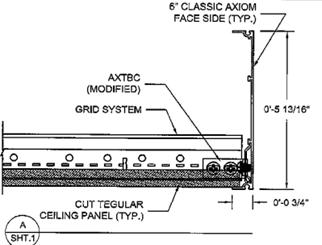


18 | Estimating Today
Sample radius detail for edge trim
Sample hanging detail
Sample edge detail 1

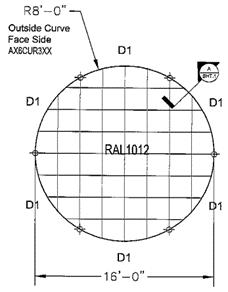



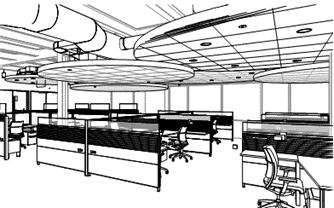
September/October| 19
Sample 3D view
Sample R6' detail
Sample R7'-6" detail
Sample R8' detail
Sample R11' detail
Sample R7' detail
*note ‐ material includes 10% add rounded up for cuts and overage
20 | Estimating Today 17 Sample estimate: Client Name:ASPE Date:4/5/2019 Overall Project Area SF:1208 Issue #:1
Description QTYUOM$/UnitTotalComments ACT 2 ‐ Grid (Yellow Color)713.00SF1.45$1,033.85Open grid only (no tile) ACT 3 ‐ Tile 615.00SF1.25$768.752' x 2' tegular edge ACT 3 ‐ Grid (White) 615.00SF1.05$645.752' x 2' T‐bar grid 12 GA wire (pre‐tied on clip)4.00Each75.11$300.44100/bundle Powder actuated shots4.00Each75.56$302.24pack of 100 White pop rivet 2.00Each9.45$18.90pack of 100 6" Axiom Edge Trim ‐ R11' ‐ 0"76.00LF30.18$2,293.68Yellow trim 6" Axiom Edge Trim ‐ R8' ‐ 0"55.00LF25.73$1,415.15White trim 6" Axiom Edge Trim ‐ R7' ‐ 6"104.00LF25.73$2,675.92White trim 6" Axiom Edge Trim ‐ R7' ‐ 0"49.00LF30.18$1,478.82Yellow trim 6" Axiom Edge Trim ‐ R6' ‐ 0"42.00LF30.18$1,267.56Yellow trim 6.625%$808.32NJ Sales Tax $13,009.38 Fasteners to deck 8.00HR75$600.00 Grid system 12.00HR75$900.00 Edge trim 10.00HR75$750.00 ACT installation 17.00HR75$1,275.00 Cleanup 1.50HR55$82.50 Debris removal 1.00HR55$55.00 Material delivery 2.00HR55$110.00 Client/design review meeting2.00HR75$150.00 $3,922.50 Manlift 1.00Week575$575.00 Perry Scaffold 1.00Month92.16$92.16 Construction signs 1.00Each75$75.00 Mobilization 2.00Each350$700.00Delivery/pick‐up charge PPE rental 51.00HR20$1,020.00 $2,462.16 $19,394.04 12.00%$2,327.28 2.00%$387.88 10.00%$1,939.40Overhead/indirect costs 7.00%$1,357.58Markup ‐ profit $25,406.19 Total labor cost Material Labor (Non‐Union/Regular Time/Carpenter Rate) Total material cost Material tax Tools/Equipment/Rental Total labor cost Fees and Totals Total direct and indirect cost Total material, labor, equipment Contingency Insurance General conditions Fee
Glossary and Acronyms
The following are the most common manufacturing companies for product information and installation methods. .
• ACT – acoustical ceiling tile
• BIM – building information modeling
• BOD – basis of design
• BOE – basis of estimate
• CapEx – capital expenditure
• GMP – guaranteed maximum price
• LF – linear feet
• MEPF – mechanical, electric, plumbing, fire
• OSHA – Occupation Safety and Health Administration
• PPE – personal protective equipment
• QA – quality assurance
• QC – quality control
• QTY – quantity
• RCP – reflected ceiling plan
• RFI – request for information
• RFP – request for proposal
• ST3 – sales tax form (resale certificate)
• ST8 – sales tax form (certificate of exempt capital improvement)
• SoW – scope of work
• SF – square feet
• UoM – unit of measurement
References
The following links are the most common manufacturing companies for product information and installation methods.
The following are the most common manufacturing companies for product information and installation methods.
Manufacture info:
https://www.armstrongceilings.com/commercial/en-us/commercial-ceilings-walls/ceilings.html https://www.usg.com/content/usgcom/en/products/ceilings.html
https://www.certainteed.com/commercial-ceilings/ https://www.hunterdouglasarchitectural.com/ceilings/index.jsp
Quantity takeoff software: https://www.planswift.com/ https://www.bluebeam.com/ https://www.oncenter.com/ https://etakeoff.com/ https://www.isqft.com/start/
Common cost database options: https://www.rsmeans.com/ https://www.dcd.com/
https://www.craftsman-book.com/
September/October| 21
Like Sands Through the Hourglass ...
 By: Vince Bailey| Estimator/Project Manager | AWCI’s Construction Dimensions
By: Vince Bailey| Estimator/Project Manager | AWCI’s Construction Dimensions

Some years ago I was asked to conduct a seminar of sorts on effective time management. I was a bit taken aback at this invitation, as I’d never been accused of being any kind of paragon of productivity. Don’t get me wrong—I’m no slacker, either. I just never gave the subject of time management much consideration before receiving that dubious request. In fact, I was convinced that this assignment was destined to be a waste of time itself—until I did some research into the issue. Now, after reading several astute pieces on the topic, I’ve become a sadder but wiser shepherd of my own hours, and now I am here to share what I learned with fellow bidmeister.
I’ll begin with an observation about how important good time management applies to construction managers, and specifically to estimators. I’ve penned several pieces here concerning the staggering amount of tasks that befall those of us in construction management—they are so numerous that just itemizing them is a chore. Couple this with the kind of deadlines that estimators are subjected to, and combine it all with the steep rates that our employers pay for our hours spent. Now, the relevance and the value of saving time in our occupations becomes clear.
In order to take control of spending time, one must first determine how one’s time is currently spent. I’ve found that the most effective approach in this regard is to start a written journal identifying where, how, and how much I presently spend my time. I’m not trying to be glib when I warn not to waste too much time with this. Just a few jotted notes each day for a typical week will go a long way toward identifying where the time flies, without intruding too much on an already demanding work load. Honesty here is more valuable than volume, so I remind myself that this informal audit is for my own benefit and not for sharing.
After a few days of keeping track, some of the most flagrant time-wasters begin to surface. For instance, consider how advances in communication technology have given us modes of interaction that are invaluable in our dayto-day dealings. Notice that they also present tentacles of commerce that inevitably entice us into unproductive browsing. We all maintain essential contacts and perform vital tasks through email and text messages. But most of us refer to these avenues more often than necessary, and for some reason, they seem to become stepping stones for less productive media, like Facebook and Twitter. Clearly, keeping time spent on social media at a minimum is a great starting place for most of us to reclaim significant time for productivity.
This epiphany regarding time-wasters reveals the power of jotting things down, and so we begin to convert our vaporous thoughts into notes that keep us focused. We begin to make lists—daily and weekly tasks. Consequently, we start to identify our listed tasks by prioritizing them with different degrees of importance and differing levels of urgency. I must recognize here that as estimators, our urgency is pretty well determined externally—in the form of assigned deadlines— and most of us have already developed a sequential method for our similar tasks as a matter of course. That is to say there is a common way that we quantifiers approach most estimates task-by-task that we’ve previously established through regular practice. Even so, there are tasks that befall us that fall outside the realm of constructing an estimate: follow-up calls, upgrading databases or meeting with clients. This is not even to mention the many of us who double as project managers. So we can say that awareness of time management and making lists is significantly helpful for bidmeisters who only estimate, and critical for double-duty folks.
Another painful truth to emerge from a casual audit is that we tend to spend more time on a number of tasks than seems reasonable. This is mostly due from the simple fact that we don’t have a clock ticking in the background—a condition that can easily be remedied by assigning a reasonable amount of time for a task before hand, and sticking to the self-imposed deadline no matter what. We can do this because we are, after all, estimators.
Of course, there are many more strategies for saving time on the books, but I think the best ones are self-created and self-imposed. So starting to jot down current distractions and making some lists can open the door to significant time savings that will help any bidmeister who can afford to (dare I say it?) invest a little extra time for it.
22 | Estimating Today
Reprinted with permission from the Association of the Wall and Ceiling Industry and the August 2022 issue of AWCI’s Construction Dimensions.
Unified Building Group (UBG) is a nationally licensed construction company with offices located in Broomfield, CO, West Palm and Pompano Beach, FL. UBG specializes in the telecommunications, corporate real estate, educational, power, energy, health care, restaurants, residential and commercial industries. UBG’s core capabilities range from real estate, site acquisition, investment, pre-construction, construction management, design build, to complete building lifecycle facilities management and maintenance. Our team has a combination of over 300 years of construction industry experience. UBG was formed to change the way the industry builds, collaborates and executes on projects. With branches in Arizona, California, Colorado and Florida, we are here to serve you!



The 2023 ASPE Membership Directory is now available in the Members Only section of ASPEnational.org. Please note that the information contained in the directory was generated on March 13, 2023, and does not reflect additions or revisions made after this date.





















Up to $25,000 to be Awarded



You may view current member data anytime using the searchable online member database – learn how! -











Application Due Date - April 28, 2023






























































































































https://scribehow.com/shared/How_to_Search_ the_ASPE_Member_Database__oUkVfEKzSCmvhe4hl231-Q



























































































































































September/October| 23
Construction Estimating Mistakes
By: Kendall Jones| ConstructionConnect |Blogs

Estimating is one of the most difficult jobs in construction. It is also one of the most important. Profits are typically won or lost based on how accurate your estimates are and how closely they match up to your final project costs.
So, ho w accurate are your estimates? A survey from QuickBooks and TSheets shows that nearly a third of construction companies make less profit than expected based on their estimates. That’s not too surprising given that 40% of respondents aren’t that confident in their estimates.
Chan ces are that one bad estimate on a project that loses money won’t put you out of business. String together a couple of
unprofitable projects and you might find yourself closing the doors for good. A quarter of all respondents indicated that it would only take two or three bad estimates to ruin their business.
Getting accurate estimates is no easy task and a good estimator is worth their weight in gold. There are a lot of variables that must be accounted for to deliver accurate estimates on every project. Everything from nailing down accurate labor and material costs and understanding workers’ productivity, to getting precise takeoff measurements and factoring in items like risk contingencies and overhead must be nearly perfect.
One or two mistakes could throw your estimates completely off and will result in a bad bid, one that you will either lose because it’s too high or win because it’s so low that you won’t make a profit. Here’s a look at some of the most common construction estimating mistakes and how to prevent them.
Not Conducting a Site Visit
Most bidding opportunities provide prospective bidders with a chance to attend a pre-bid meeting and visit the jobsite. Often, these are mandatory in order to submit a bid and with good reason. No two jobsite are identical and unknown site conditions can cause unexpected, and costly, issues when construction gets underway.
When conducting a site visit you’ll want to take measurements, inspect the topography, and take some soil bore samples if that hasn’t already been done. You also want to look at road access and traffic to the site, determine how much space there is for staging, equipment and materials delivery and storage, and what environmental protections will be needed during construction.
Be sure to have any subcontractors whose work may be impacted by the site condition make a visit as well. This allows them to assess the site for themselves and factor in any additional costs that existing site conditions might present into their estimates and bids.
24 | Estimating Today 8 Common
01.
02.
Inaccurate Takeoffs
Your takeoffs lay the groundwork for your estimates. If they’re incomplete or incorrect it can really screw up your estimates. Accurate takeoffs help you determine the exact quantities needed for all your materials and supplies. They are also required to determine your labor and equipment needs. If you miss items during takeoff or don’t get accurate measurements, you’ll either overestimate the project and not win the bid or you’ll underestimate and risk winning a project that won’t be profitable. Takeoff software is a great option to ensure that you get accurate measurements for your estimates. It’s also a huge time saver over doing takeoffs manually. These tools are only as good as the user, so it’s important that estimators get the proper training and are comfortable using the software.
03.
Making Uneducated Guesses
Don’t gamble on your bids by making uninformed or uneducated guesses in your estimating. Tracking job costs on every project is a great way to ensure your estimates, and ultimately your bids, are as accurate as possible.
Job costs for labor, materials, and equipment should be based on the most current data available. Make sure to factor in overhead costs and soft costs such as those for permitting and inspections that can often be forgotten or neglected. You also want to make sure that you have the workforce and equipment available for the project. Having to unexpectedly subcontract additional work or rent extra equipment can quickly eat up your profits or wipe them out completely.

September/October| 25
04.
Labor Costs
Labor costs are probably the hardest item to nail down accurately when it comes to your estimate. In that survey from QuickBooks and TSheets, construction business owners say “labor costs are the hardest to estimate and are ranked as the most expensive project cost.” There are several variables in play when it comes to estimating labor costs including the number of available workers for the project, their experience level, rate of pay, and productivity.
A good, experienced worker may make a higher salary but are more productive and can get more done in less time than a worker with less experience who makes a lower salary. Focus on determining how many man-hours it takes to perform a task to use as a guide when estimating labor costs.
Don’t forget to determine whether prevailing wages are required on the project, which may or may not be different from what you typically pay each worker. Always keep records of job costs, especially labor costs, as you can use this historical data for more accurate estimates on future projects.
05.
Material and Supplies Costs
Building materials and supplies are another big cost for construction projects and rank high in being hard to accurately estimate. Prices for materials can fluctuate dramatically from the time you start an estimate to the time that construction commences. Demand for materials is high and uncertainty over tariffs and their impact on prices are making it even harder to get estimates right.
Establishing relationships with your building product manufacturers and suppliers has its advantages. Not only can they help you lock in accurate prices while you put together your estimates, but they can also steer you to alternative materials that might be a better fit for your project.
Locking in prices for your materials is crucial but don’t forget to make sure that you provide quantities to your suppliers. This allows them to ensure they can fulfill your order and deliver on time. Costly delays caused by workers not having the materials they need is embarrassing and will hurt your bottom line.
06.
Failing to Assess Risks and Creating Contingencies
Every construction project comes with risks. Completing a risk assessment should be part of your estimating process. For one, it helps in your bid/no-bid decision-making. A good estimator can identify a project that is too risky and pass on submitting a bid. It also helps to determine how much to estimate for contingencies.
Failing to assess risks and build in contingencies to your estimate will be detrimental when things go wrong. The bigger the risk, the more time you should spend on determining ways to mitigate them and how that could impact your costs. You likely won’t be able to recoup the losses that occur should an unforeseen issue crop up once construction is underway.
26 | Estimating Today
Not Reviewing Your Work
Everyone makes mistakes. Estimators are no exception. Small estimating errors or omissions might not make much of an impact but big ones like omitting scope items, inaccurate measurement, or using the wrong units of measure can spell trouble. Take the time to carefully review your work or have another person on your estimating team review your estimates. Double-check your measurements are accurate, and your math is correct for all your costs.
Give yourself adequate time to put your estimates and bid together. Rushing through your work just to meet a bid deadline will only result in mistakes that will cost you in the end, so take the time to get it right the first time. Profitability on a project is almost always determined by your estimates. If you underestimate your bid, there’s usually no amount of cost-cutting measures that will be able to make up for the shortfall.
Not Reviewing Subcontractor Estimates
If you’re a general contractor, chances are you are going to have to subcontract out some of the work to trade contractors. Be sure to review their bid estimates and proposals thoroughly. Make sure they understand exactly what aspects of the projects you are wanting them to bid on and complete. This will avoid duplication of work in their estimates that are being covered by you or another subcontractor.

September/October| 27
07.
08.
ASPE COnsultants Listing Nationwide Page Enhanced Standard Enhanced listing on national page Enhanced listing on one state page Listing on one state page Company logo (PNG format) 50 - word narrative Additional state(s) - $25 ea. $400 $150 $50 Listing on one state page Additional state(s) - $25 ea. For ASPE member Estimating Consultants only! Advertise your services locally, regionally, or nationally on the ASPE website. Choose the package that’s right for you. Looking to hire an Estimating Consultant? Browse our listings: https://bit.ly/46Mmawl Company logo (PNG format) 75 - word narrative Additional state(s) - $25 ea. 25 - word narrative
THE BENEFITS OF GETTING YOUR C i CE
How Getting Your CiCE Can Benefit Your Career:


•Excel in the workplace
•Gain new opportunities
•Propel your career
CONSTRUCTION ESTIMATING
ASPE’s very own Certificate in Construction
Estimating is comprised of six required courses focused on the core competencies and fundamentals necessary for a beginning estimator to master. This program is a comprehensive introduction to the foundational principles in plan reading, estimating math, bidding practices, materials and processes, preparing an estimate, and more. Whether you’re new to estimating, need a refresh, or are looking for a training program for your staff, ASPE’s Certificate in Construction
Estimating is the up-to-date solution to accessible online estimating education.
28 | Estimating Today
COURSES ARE:
Basic Estimating Math
Plan Reading for Estimating
Introduction to Construction Estimating I
Introduction to Construction Estimating II


Construction Materials and Processes I
Brand New Estimators
While there is no college degree in estimating, this certificate will educate you on all the ins-and-outs of the estimating profession so that you can jump into an exciting new career.
WHO SHOULD EARN THIS CERTIFICATE:
Field Workers Looking For An Office Job
If you’ve been working in the field for any amount of time, you know how hard the day-to-day demands can be on your body. With this certificate, you can learn a new skill and enjoy a career indoors, behind a desk.


Estimating and Bidding WE CAN HELP YOU GET

Seasoned Estimators
Has it been a while since you refreshed your basic skillset in estimating? Or are you
September/October| 29 SCAN QR CODE TO REGISTER | 615.316.9200 | www.aspenational.org |
STARTED
2023 Critical Calendar 2024 Critical Calendar
2 2024 Membership Renewals Begin
2 2024 Certification Renewals Begin (CPE and AEP) November
October
23-24 SBO Closed for Thanksgiving
25 - 26 SBO Closed for the Holidays
31 2024 Membership Renewals Due
31 2024 Certification Renewals Due (CPE and AEP)
December
1 New Fiscal Year Begins
22 Estimating Academy Classes Begin
31 ASPE Membership: Membership suspended for non-renewal (Renewal due 12/31/2023)
31
AEP/CPE Status: Expiring /AEP's/CPE's revoked for non-renewal (Renewal due 12/31/2023)
31 Deadline: Member Profile Updates for inclusion in 2024 Directory
January
30 | Estimating Today
BENEFITS OF BECOMING CERTIFIED
VALIDATE YOUR EXPERTISE
2015
EARN A DISTINGUISHED CERTIFICATION
ASPE CPE Certification is accredited by the Council of Engineering and Scientific Specialty Boards (CESB), and successfully credentialed candidates of the program earn recognition for their skills.
GAIN A COMPETITIVE ADVANTAGE
More projects across the country are seeking credentialed estimators as an extra assurance of the quality of work. Increasingly, local, state, and government agencies are moving towards requiring CPE certification.
BOOST CAREER OPPORTUNITIES
Enhance your career by opening doors to the diverse projects and career growth opportunities that the CPE credential confers.
PROGRAM REQUIREMENTS
CERTIFIED PROFESSIONAL ESTIMATOR (CPE)
• For estimators with more than 5 years professional experience
• 3 – 6 month timeline to complete
• Required to complete the General Estimating Knowledge (GEK) exam, Technical Paper submission, and Part I and Part II of the Discipline Specific Test (DST)
ASSOCIATE ESTIMATING PROFESSIONAL (AEP)
• For estimators with less than 5 years professional experience
• 3 month timeline to complete
• Required to pass the General Estimating Knowledge (GEK) exam

| 615.316.9200 | www.aspenational.org | SCAN QR CODE TO LEARN MORE
ASPE CHAPTER MEETINGS
ARIZONA
Arizona #6
Where: Aunt Chilada's Website: n/a
Meeting Contact: Madison Williams MaWilliams@climatec.com
ARKANSAS
Arkansas #33
Where: Varies
Website: n/a
Meeting Contact: Jack Guess, CPE jguess@baldwinshell.com
NW Arkansas #79
Where: Varies
Website: n/a
Meeting Contact: Danny Chadwick, CPE estimatordan@gmail.com
CALIFORNIA
Los Angeles #1
Where: Virtual Website: ASPE-LA1.org
Meeting Contact: Bruce Danielson la1ofaspe@outlook.com
Golden Gate #2
Where: Virtual Website: aspe2.org
Meeting Contact: Robert Muir, CPE robmuir72@hotmail.com
Orange County #3
Where: Virtual Website: aspe-oc3.org
Meeting Contact: Troy Thomas constructionpro1984@yahoo.com
CALIFORNIA (CONTINUED)
San Diego #4
Where: Virtual Website: aspesd4.org
Meeting Contact: Paul Chang, CPE pchang@balfourbeattyus.com
Sacramento #11
Where: Varies
Website: n/a
Meeting Contact: Bryan Hall bryan_hall@surewest.net
Silicon Valley #55
Where: Virtual Website: aspe55.org
Meeting Contact: Shawna Alvarado shawna@odonnellplastering.com
COLORADO
Denver #5
Where: Virtual Website: aspedenver.org
Meeting Contact: Jennifer Farmer, AEP jennifer@livingdesignstudios.com
CONNECTICUT
Nutmeg #60
Where: Back Nine Tavern Website: n/a
Meeting Contact: Lee Sullivan lee@lionsheadcc.com
Yankee #15
Where: n/a
Website: n/a
Meeting Contact: Bill Jacabacci jacabacci@gmail.com
DELAWARE
Delware #75
Where: Virtual Website: n/a
Meeting Contact: Brett Mucklow bmucklow@bpgsconstruction.com
DISTRICT OF COLUMBIA
Greater D.C. #23
Where: Varies
Website: n/a
Meeting Contact: Carlos Rosales aspe23president@gmail.com
FLORIDA
Tampa Bay #48
Where: The Pub Resturant Website: aspetampabay.com
Meeting Contact: Ray Velez reymvelez@gmail.com
Gold Coast #49
Where: Varies Website: n/a
Meeting Contact: Danny Chadwick, CPE estimatordan@gmail.com
Orlando #50
Where: Anser Advisory Website: https://aspeorlando50.com
Meeting Contact: Andrew Kleimola akleimola@anseradvisory.com
GEORGIA
Atlanta #14
Where: Virtual Website: n/a
Meeting Contact: Danny Chadwick, CPE estimatordan@gmail.com
32 | Estimating Today
ASPE CHAPTER MEETINGS (CONTINUED)
ILLINOIS
Chicago #7
Where: Virtual Website: n/a
Meeting Contact: Matt Burress, CPE mburress@performanceservices.com
INDIANA
Central Indiana #59
Where: Varies
Website: n/a
Meeting Contact: Jeremy Adkins, CPE jadkins@wccci.com
Old Fort #65
Where: Virtual Website: aspechapter65.org
Meeting Contact: Thad Berkes tberkes@designcollaborative.com
IOWA
Quad Cities #71
Where: Varies
Website: aspequadcities.org
Meeting Contact: Scott Robinson, LCPE scottr@jlbradyco.com
Greater Des Moines #73
Where: Varies
Website: iowaaspe73.org
Meeting Contact: Hui (Huey) Su huey@concordconst.com
LOUISIANA
New Orleans #9
Where: Varies
Website: n/a
Meeting Contact: Danny Chadwick, CPE estimatordan@gmail.com
MAINE
Maine #37
Where: Varies Website: aspemaine.com
Meeting Contact: John Brockington, CPE jbrockington@woodwardcurran.com
MARYLAND
Baltimore #21
Where: Varies Website: n/a
Meeting Contact: Steve Dooley, CPE sdooley@phoenix-eng.com
MASSACHUSETTS
Boston #25
Where: Virtual Website: n/a
Meeting Contact: Eric Rennell eric@rennellcapitalgroup.com
MICHIGAN
Detroit #17
Where: Virtual Website: aspe17.org
Meeting Contact: Glenn Frank, CPE glenn.frank@ymail.com
MISSOURI
St. Louis Metro #19
Where: AGC Training School
Website: aspe19stlouis.org
Meeting Contact: John Smith, CPE jpsmith@tarltoncorp.com
Heartland #32
Where: Varies Website:aspe32.org
Meeting Contact: Eric Soriano
esoriano @hermeslandscaping.com
NEW JERSEY
Garden State #26
Where: Virtual Website: n/a
Meeting Contact: Robert Sibilia, CPE sibiliaconstructionservicesllc @gmail.com
NEW MEXICO
Roadrunner #47
Where: Fiestas Restaurant Website: n/a
Meeting Contact: Joshuah Crooker-Flint, CPE joshc@auiinc.net
NEW YORK
New York #10
Where: Virtual Website: n/a
Meeting Contact: Rose Jesse, CPE rosejesse.aspe@gmail.com
Empire State #42
Where: Athos Resturant
Website: n/a
Meeting Contact: Alvaro Garza, CPE Alvaro.garza@nationalgrid.com
OHIO
Southwestern Ohio #38
Where: Varies
Website: aspe-cincinnati.org
Meeting Contact: Dan Frondorf, CPE dan@dgfrondorf.com
September/October| 33
ASPE CHAPTER MEETINGS (CONTINUED)
OKLAHOMA
Landrun-OK City #80
Where: Varies
Website: aspeok.org
Meeting Contact: Mike Phillips, CPE michaelp@miller-tippens.com
OREGON
Columbia-Pacific #54
Where: Varies
Website: n/a
Meeting Contact: Steve Watkins steve.watkins@bnbuilders.com
PENNSYLVANIA
Three Rivers #44
Where: Varies
Website: n/a
Meeting Contact:
Dexter Murphy, LCPE dextercmurphy@comcast.net
Philadelphia #61
Where: Varies
Website: n/a
Meeting Contact: Stephen Biddle SBiddle@oliverfps.com
Central Pennsylvania #76
Where: Loxley's Resturant
Website: n/a
Meeting Contact: Shawn Buckwalter, CPE sbuckwalter@egsconstruction.com
TENNESSEE
Middle Tennessee #34
Where: Varies
Website: n/a
Meeting Contact: Ricky Sanford Rsanford7159@gmail.com
TEXAS
Houston #18
Where: Varies
Website: n/a
Meeting Contact: Larry Lucero, CPE llucero@redlineinsulation.com
Rio Grande #40
Where: Varies
Website: n/a
Meeting Contact: Rodolfo Barba, CPE rodolfobarba1@gmail.com
Dallas/ Ft.Worth #43
Where: Virtual Website: sites/google.com/view/aspe-dfw
Meeting Contact: Steve Patmon ASPE.dfw@gmail.com
UTAH
Great Salt Lake #51
Where: Virtual Website: na
Meeting Contact: M. John Shampton, CPE mjohnshampton@gmail.com
VIRGINIA
Richmond #82
Where: Varies
Website: aspe-richmond.org
Meeting Contact: Sid Bass, CPE sbass@reynolds.edu
WASHINGTON
Puget Sound #45
Where: Virtual Website: na
Meeting Contact: Steve Watkins steve.watkins@bnbuilders.com
WISCONSIN
Brew City #78
Where: Varies
Website: na
Meeting Contact: Matt Washkoviak, CPE mattwashkoviak@camosy.com
Please Note: Information is subject to change. Report changes in your Chapter’s information with an email to Tina@ASPEnational.org
34 | Estimating Today
Membership Classification Count (as of 6/6/2023) Affiliate AEP Corporate CPE Estimator Fellow Honorary Member LCPE Member Emeritus ME (CPE or LCPE) Student Total 52 62 8 376 657 23 5 100 11 30 30 1,354

September/October| 35 The industry standard for search! Exclusively for commercial construction professionals, like you! TheBlueBook.com/ASPE (844) 617-2478 BUILDING RELATIONSHIPS SINCE 1913 BUILDING RELATIONSHIPS SINCE 1913 • Quick & easy access to the nation’s largest database of qualified commercial construction professionals • Find exactly who you need, where and when you need them • Always available, always up-to-date
ASPE CORE VALUES
EDUCATION:
ASPE educates and mentors professional estimators for the sustainability of the construction industry.
PROFESSIONALISM:
ASPE promotes the lifelong pursuit of excellence and credibility in professional estimating.

ASPE CORE PURPOSE
ASPE is the construction industry’s leader and recognized authority in professional estimating through excellence in education, certification and standardization.
FELLOWSHIP:
ASPE develops a fellowship of professional estimators that connects and leads the construction industry.
215 Donelson Pike, #140710 • Nashville, Tennessee 37214 • 615.316.9200 • ASPEnational.org







 By: Josh Huck | Estimatica, Inc.
By: Josh Huck | Estimatica, Inc.




































 By: Vince Bailey| Estimator/Project Manager | AWCI’s Construction Dimensions
By: Vince Bailey| Estimator/Project Manager | AWCI’s Construction Dimensions
























































































